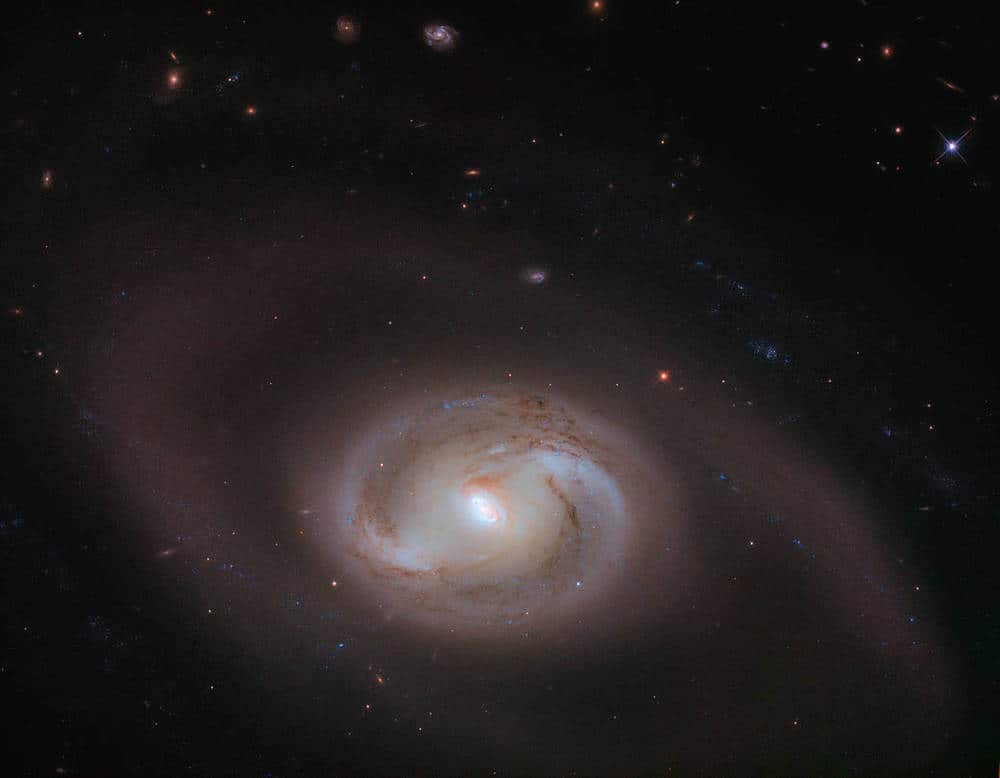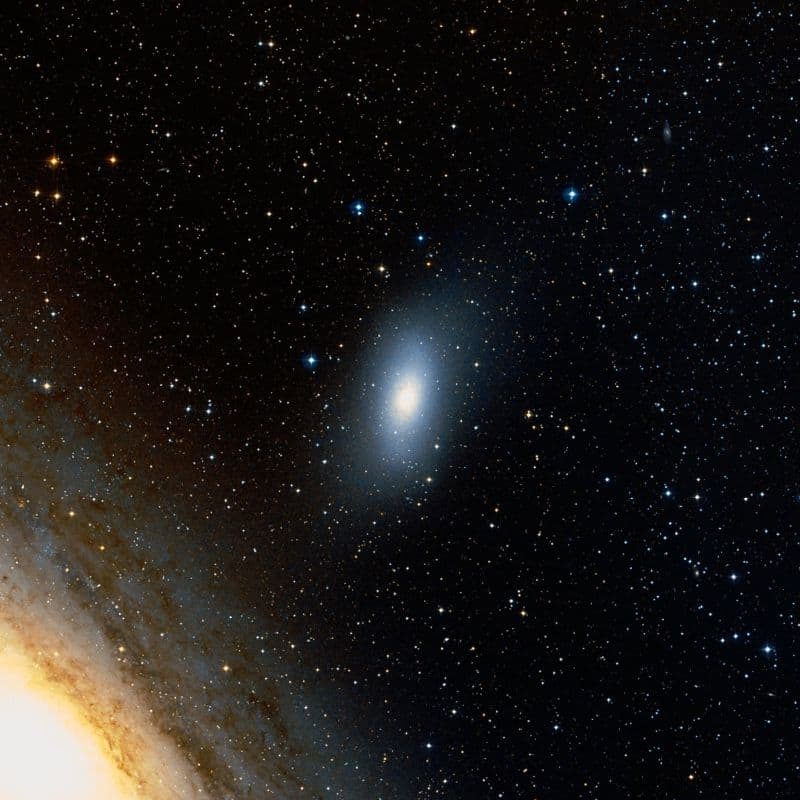Blog
At first glance, the subject of this NASA/ESA Hubble Space Telescope image looks to be a simple spiral galaxy, with two pinwheeling arms emerging from a central bar of stars and material that cuts through the galactic center. In fact, there are rings within these spiral arms, too: spirals within a spiral.
This kind of morphology is known as a multiring structure. As this description suggests, this galaxy, named NGC 2273, hosts an inner ring and two outer “pseudorings.” Having so many distinct rings is rare and makes NGC 2273 unusual. Rings are created when a galaxy’s spiral arms appear to loop around to nearly close upon one another, combined with a trick of cosmic perspective. NGC 2273’s two pseudorings are formed by two swirling sets of spiral arms coming together, and the inner ring by two arcing structures nearer to the galactic center, which seem to connect in a similar way.
These rings are not the only interesting feature of this galaxy. NGC 2273 is also a Seyfert galaxy, a galaxy with an extremely luminous core. In fact, the center of a galaxy such as this is powered by a supermassive black hole, and can glow brightly enough to outshine an entire galaxy like the Milky Way.

Daniel Richard Gottlieb (born April 18, 1953) is an American drummer. He was a founding member of the Pat Metheny Group, and was co-founder of Elements with Mark Egan. Gottlieb was born in New York City on April 18, 1953. He took lessons from Mel Lewis and Joe Morello and graduated from the University of Miamiin 1975. Morello was his lifelong teacher, beginning in 1968 and through the late 1990s. He became a member of the Gary Burton Quartet in 1976 with Pat Metheny. He was one of the original members of The Pat Metheny Group from 1977 to 1983.Bassist Mark Egan was also in Metheny’s first group. Egan and Gottlieb formed the band Elements.
In 1982, Gottlieb toured with Flora Purim and Airto Moreira. Gottlieb played with singer Michael Franks in 1983, and the following year toured with trumpeter Randy Brecker and saxophonist Stan Getz. He was, for a short time in 1984, a member of the Mahavishnu Orchestra led by guitarist John McLaughlin. He was a regular member of Gil Evans‘ orchestra from 1986 until Evans died two years later.
“From 1991 Gottlieb made a number of visits to Germany to perform with the WDR Big Band in collaboration with Bob Brookmeyer, George Gruntz, and Dino Saluzzi.”In the mid-1990s he was part of less jazz-oriented and more vocal-based performances: Booker T. & the M.G.’s, and accompanying The Manhattan Transfer.
more...Clyde Austin Stubblefield (April 18, 1943 – February 18, 2017) was an American drummer best known for his work with James Brown. A self-taught musician, he was influenced by the sound of natural rhythms around him. His drum patterns on Brown’s recordings are considered funk standards. He recorded and toured with Brown for six years and settled in Madison, Wisconsin, where he was a staple of the local music scene. Often uncredited, samples of his drum patterns were heavily used in hip hop music. He was the recipient of an honorary doctorate in fine arts.
Born to Frank D. and Vena Stubblefield on April 18, 1943, he grew up in Chattanooga, Tennessee. He was inspired to pursue drumming after seeing drummers for the first time in a parade. As a youngster his sense of rhythm was influenced by the industrial sounds of factories and trains around him. He practiced the rhythm patterns he heard, sometimes playing two patterns simultaneously. Years later he said if he could hum a drum pattern, he could play it. He played professionally as a teenager and performed in local bands such as Blue Shufflers, Inclines, and Cascades. In early 1960s he moved to Macon, Georgia, and worked with guitarist Eddie Kirkland and toured with Otis Redding.
more...Clarence “Gatemouth” Brown (April 18, 1924 – September 10, 2005) was an American musician from Louisiana and Texas known for his work as a blues musician, as well as other styles of music. He spent his career fighting purism by synthesizing old blues, country, jazz, Cajun music and R&Bstyles. His work also encompasses rock and roll, rock music, folk music, electric blues, and Texas blues.
He was an acclaimed multi-instrumentalist, who played an array of musical instruments, including the guitar, fiddle, mandolin, viola, harmonica and drums. He won a Grammy Award for Best Traditional Blues Album in 1983 for his album, Alright Again!. He is regarded as one of the most influential exponents of blues fiddle and has had enormous influence in American fiddle circles.
Brown’s two biggest musical influences were Louis Jordan and T-Bone Walker.
Brown was born in Vinton, Louisiana, and raised in Orange, Texas. His professional music career began in 1945, playing drums in San Antonio, Texas. He was given the nickname “Gatemouth” by a high school teacher who said he had a “voice like a gate”.His career was boosted when he attended a concert by T-Bone Walker in Don Robey‘s Bronze Peacock Houston nightclub in 1947; Walker became ill, and Brown took up his guitar and quickly wrote and played “Gatemouth Boogie”, to the delight of the audience.
more...Leo Parker (April 18, 1925 – February 11, 1962) was an American jazz musician who played baritone saxophone.
Born in Washington, D.C., Parker studied alto saxophone in high school, and played this instrument on a recording with Coleman Hawkins in 1944. He switched to baritone saxophone later that year when he joined Billy Eckstine‘s bebop band, playing there until 1946. In 1945 he was a member of the so-called “Unholy Four” of saxophonists, with Dexter Gordon, Sonny Stitt and Gene Ammons. He played on 52nd Street in New York with Dizzy Gillespie in 1946 and Illinois Jacquet in 1947-48, and later recorded with Fats Navarro, J.J. Johnson, Teddy Edwards, Wardell Gray and Charles Thompson. He and Thompson had a hit with their Apollo Records release, “Mad Lad”.
In the 1950s, Parker had problems with drug abuse, which interfered with his recording career. He made two comeback records for Blue Note in 1961, but the following year he died of a heart attack in New York CIty. He was 36.
On June 25, 2019, The New York Times Magazine listed Leo Parker among hundreds of artists whose material was reportedly destroyed in the 2008 Universal fire.
more...Eurreal Wilford “Little Brother” Montgomery (April 18, 1906 – September 6, 1985) was an American jazz, boogie-woogie and blues pianist and singer.
Largely self-taught, Montgomery was an important blues pianist with an original style. He was also versatile, working in jazz bands, including larger ensembles that used written arrangements. He did not read music but learned band routines by ear—once through an arrangement and he had it memorized. Montgomery was born in Kentwood, Louisiana, United States, a sawmill town near the Mississippi border, across Lake Pontchartrain from New Orleans, where he spent much of his childhood. Both his parents were of African-American and Creek Indian ancestry. As a child he looked like his father, Harper Montgomery, and was called Little Brother Harper. The name evolved into Little Brother Montgomery, and the nickname stuck. He started playing piano at the age of four, and by age 11 he left home for four years and played at barrelhouses in Louisiana. His main musical influence was Jelly Roll Morton, who used to visit the Montgomery household.
more...
The Dumbbell Nebula — also known as Messier 27 or NGC 6853 — is a typical planetary nebula and is located in the constellation Vulpecula (The Fox). The distance is rather uncertain, but is believed to be around 1,200 light-years. It was first described by the French astronomer and comet hunter Charles Messier who found it in 1764 and included it as no. 27 in his famous list of extended sky objects .Despite its class, the Dumbbell Nebula has nothing to do with planets. It consists of very rarified gas that has been ejected from the hot central star (well visible on this photo), now in one of the last evolutionary stages. The gas atoms in the nebula are excited (heated) by the intense ultraviolet radiation from this star and emit strongly at specific wavelengths.
This image is the beautiful by-product of a technical test of some FORS1 narrow-band optical interference filtres. They only allow light in a small wavelength range to pass and are used to isolate emissions from particular atoms and ions. In this three-colour composite, a short exposure was first made through a wide-band filtre registering blue light from the nebula. It was then combined with exposures through two interference filtres in the light of double-ionized oxygen atoms and atomic hydrogen. They were colour-coded as “blue”, “green” and “red”, respectively, and then combined to produce this picture that shows the structure of the nebula in “approximately true” colours.
They are three-colour composite based on two interference ([OIII] at 501 nm and 6 nm FWHM — 5 min exposure time; H-alpha at 656 nm and 6 nm FWHM — 5 min) and one broadband (Bessell B at 429 nm and 88 nm FWHM; 30 sec) filtre images, obtained on September 28, 1998, during mediocre seeing conditions (0.8 arcsec). The CCD camera has 2048 x 2048 pixels, each covering 24 x 24 µm and the sky fields shown measure 6.8 x 6.8 arcminutes and 3.5 x 3.9 arcminutes, respectively. North is up; East is left.

Jan Hammer (Czech pronunciation: [ˈjan ˈɦamɛr]) (born 17 April 1948) is a Czech-American musician, composer and record producer. He first gained his most visible audience while playing keyboards with the Mahavishnu Orchestra in the early 1970s, as well as his film scores for television and film including “Miami Vice Theme” and “Crockett’s Theme“, from the 1980s television program, Miami Vice. He has continued to work as both a musical performer and producer, expanding to producing film later in his career.
Hammer has collaborated with some of the era’s most influential jazz and rock musicians such as John McLaughlin, Jeff Beck, Al Di Meola, Mick Jagger, Carlos Santana, Stanley Clarke, Tommy Bolin, Neal Schon, Steve Lukather and Elvin Jones. He has composed and produced at least 14 original motion picture soundtracks, the music for 90 episodes of Miami Vice and 20 episodes of the television series Chancer. His compositions have won him several Grammy Awards.
Jan Hammer was born in Prague, then capital of Czechoslovakia (now the Czech Republic).
more...Charles Anthony “Buster” Williams (born April 17, 1942 in Camden, New Jersey) is an American jazz bassist. Williams is known for his membership in pianist Herbie Hancock‘s early 1970s group, working with guitarist Larry Coryell from the 1980s to present, working in the Thelonious Monk repertory band Sphere and as the accompanist of choice for many singers, including Nancy Wilson.
Williams’ father, Charles Anthony Williams, Sr., was a musician who played bass, drums, and piano, and had band rehearsals in the family home in Camden, New Jersey, exposing Williams to jazz at an early age. Williams was particularly inspired to focus on bass after hearing his father’s record of Star Dust, performed by Oscar Pettiford, and started playing in his early teens. He had his first professional gig while he was still a junior high school student, filling in for Charles, Sr., who had double booked himself one evening. Williams later spent his days practicing with Sam Dockery, who was playing in Jimmy Heath‘s band in Philadelphia on a regular double bill with Sam Reed.
https://www.youtube.com/watch?v=ecrxBezA1mc
more...Johnny St. Cyr (April 17, 1890 – June 17, 1966) was an American jazz banjoist and guitarist.
St. Cyr was born in New Orleans, Louisiana. He played for several leading New Orleans bands before moving to Chicago in 1923.[1] He is most commonly remembered as a member of Louis Armstrong’s Hot Five and Hot Seven bands. He also played with Jelly Roll Morton‘s Red Hot Peppers. He composed the popular standard “Oriental Strut“, noted for its adventurous chord sequence.
From 1961 until his death in 1966, St. Cyr was the bandleader of the Young Men from New Orleans, who performed at Disneyland. He died in Los Angeles, California, and is buried in Evergreen Cemetery, in Los Angeles.
more...Isabel Vargas Lizano (Spanish pronunciation: [tʃaˈβela ˈβaɾɣas]; 17 April 1919 – 5 August 2012), better known as Chavela Vargas, was a Costa Rica-born Mexican singer. She was especially known for her rendition of Mexican rancheras, but she is also recognized for her contribution to other genres of popular Latin American music. She was an influential interpreter in the Americas and Europe, muse to figures such as Pedro Almodóvar, hailed for her haunting performances, and called “la voz áspera de la ternura”, the rough voice of tenderness. The Latin Academy of Recording Arts & Sciences, presented her with a Latin Grammy in 2007.
She was born in Costa Rica, in San Joaquín de Flores, as Isabel Vargas Lizano, daughter of Francisco Vargas and Herminia Lizano. She was baptized on 15 July 1919 with the forenames “María Isabel Anita Carmen de Jesús.” She had a difficult childhood: her parents divorced and left her under the care of an uncle, and she contracted poliomyelitis. She went by Chavela, which is a pet name for Isabel. At age 17, she abandoned her native country due to lack of opportunities for a musical career, seeking refuge in Mexico, where an entertainment industry was burgeoning. There she resided for almost eight decades and obtained Mexican nationality.
more...The most flamenco “bulerías” are in Phrygian mode (with the I chord mutation that becomes Major perfect, often combining melodic and harmonic turns on the I and VI).
more...Messier 110 shows evidence of recent star forming activity as it contains a population of young blue stars at its centre. It also has some dust, which is unusual for a galaxy of this type and likely a result of interaction with its large neighbour, M31. M110 is classified as a peculiar elliptical galaxy because of its unusual dark structures and signs of recent star formation. The galaxy does not appear to have a supermassive black hole at its centre.
As a satellite galaxy of M31, M110 is a member of the Local Group. It is one of at least 14 dwarf galaxies orbiting Andromeda, and the second brightest of Andromeda’s satellites, after Le Gentil (M32).
Messier 110 is often catalogued as a dwarf spheroidal galaxy, which makes it the only galaxy of this type listed in the Messier Catalogue. It is, however, much brighter than other galaxies of this kind and is sometimes classified simply as a spheroidal galaxy. M110 has an estimated mass of between 4 and 15 billion solar masses.
Messier 110 is estimated to contain about 10 billion stars and has a population of at least eight globular clusters. The brightest of these, G73, is of 15th magnitude and can be seen in large amateur telescopes. 2.674 million light years distant.

More Posts
- Ry Cooder Day
- Charles Lloyd Day
- Lightnin’ Hopkins Day
- World Music with Cañizares
- Daily Roots with the Jolly Boys
- The Cosmos with M31
- Shirley Scott Day
- Quincy Jones Day
- Georg Philipp Telemann Day
- World Music with John Carty
- Daily Roots with Ooklah the Moc
- Viktoria Sears Memorial
- The Cosmos with NGC 4698
- Blue Mitchell Day
- Roy Haynes Day
- Lightnin’ Slim Day
- World Music with Anoushka Shankar
- Daily Roots with Tommy Mccook, Richard Ace, The Skatalites & Disco Height
- The Cosmos with vdB 93
- James Taylor Day